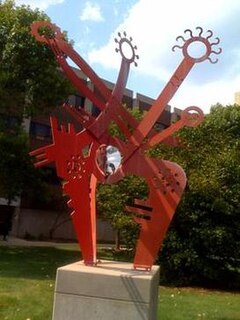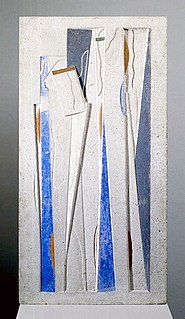
In visual art, mixed media is an artwork in which more than one medium or material has been employed. Assemblages and collages are two common examples of art using different media that will make use of different materials including cloth, paper, wood and found objects.

Paper craft is a collection of crafts using paper or card as the primary artistic medium for the creation of one, two or three-dimensional objects. Paper and card stock lend themselves to a wide range of techniques and can be folded, curved, bent, cut, glued, molded, stitched, or layered. Papermaking by hand is also an important paper craft.
Elements of art are stylistic features that are included within an art piece to help the artist communicate. The seven most common elements include line, shape, texture, form, space, colour and value, with the additions of mark making, and materiality. When analyzing these intentionally utilized elements, the viewer is guided towards a deeper understanding of the work.

Kirigami (切り紙) is a variation of origami that includes cutting of the paper, rather than solely folding the paper as is the case with origami, but typically does not use glue.

Papercutting or paper cutting is the art of paper designs. The art has evolved uniquely all over the world to adapt to different cultural styles. One traditional distinction most styles share in common is that the designs are cut from a single sheet of paper as opposed to multiple adjoining sheets as in collage.

An altered book is a form of mixed media artwork that changes a book from its original form into a different form, altering its appearance and/or meaning.

The Bronco Buster is a sculpture made of bronze copyrighted in 1895 by American artist Frederic Remington. It portrays a rugged Western frontier cowboy character fighting to stay aboard a rearing, plunging bronco, with a stirrup swinging free, a quirt in one hand and a fistful of mane and reins in the other. It was the first and remains the most popular of all of Remington's sculptures.

Numbers 1-0 is a public artwork by the American artist Robert Indiana, located at the Indianapolis Museum of Art (IMA), which is near downtown Indianapolis, Indiana. This series of sculptures is composed of 10 brightly painted numerical digits, each made of aluminum and set on its own base. Their construction took place at the former Lippincott Foundry in North Haven, Connecticut from 1980 to 1983.

Collage is a technique of art creation, primarily used in the visual arts, but in music too, by which art results from an assemblage of different forms, thus creating a new whole.

Naoko is a common feminine Japanese given name which is occasionally spelled Nahoko.

Cubist sculpture developed in parallel with Cubist painting, beginning in Paris around 1909 with its proto-Cubist phase, and evolving through the early 1920s. Just as Cubist painting, Cubist sculpture is rooted in Paul Cézanne's reduction of painted objects into component planes and geometric solids; cubes, spheres, cylinders, and cones. Presenting fragments and facets of objects that could be visually interpreted in different ways had the effect of 'revealing the structure' of the object. Cubist sculpture essentially is the dynamic rendering of three-dimensional objects in the language of non-Euclidean geometry by shifting viewpoints of volume or mass in terms of spherical, flat and hyperbolic surfaces.

Happy-Go-Luckies of Nature and Technology is a public artwork by German artist Guido Brink located on the University of Wisconsin–Milwaukee campus, which is near Milwaukee, Wisconsin, United States. The sculpture is a steel structure that is painted red. It was dedicated at UWM's Lapham Hall on October 23, 1992.

The visual arts are art forms such as painting, drawing, printmaking, sculpture, ceramics, photography, video, filmmaking, design, crafts, and architecture. Many artistic disciplines such as performing arts, conceptual art, and textile arts also involve aspects of visual arts as well as arts of other types. Also included within the visual arts are the applied arts such as industrial design, graphic design, fashion design, interior design and decorative art.

Gate to the Northwest Passage is a 1980 sculpture by Alan Chung Hung, located adjacent to the Vancouver Maritime Museum in Vanier Park in the Kitsilano neighborhood of Vancouver, British Columbia, Canada. The 4.6-metre (15 ft) sculpture of a square, cut and twisted "like a paper clip" to form an arch, is composed of weathered Corten steel that rusts to provide a protective layer. The work was installed in 1980 to commemorate the arrival of Captain George Vancouver in Burrard Inlet, following a competition sponsored by Parks Canada one year prior. Gate to the Northwest Passage received an adverse reaction initially, but reception has improved over time. The sculpture has been included in walking tours of the surrounding neighborhoods as a highlight of Vanier Park.
Nahoko Kojima is a contemporary Japanese paper cut artist. She started Kirie under private tutelage at the age of 5 and continued throughout her formative years. In 1999 she moved to Tokyo and in 2004 she graduated from a degree in Design at Kuwasawa Institute. An avid follower of fashion and trends, she found much of her inspiration in the city. She briefly pursued a career in Graphic Design in Tokyo before moving to London in 2005 to learn more of the Western culture of the Arts. Her first solo Paper Cut show in London exhibited the 5 senses collection at the Epicurean Lounge in 2007.
Leo Monahan (1933) is an artist who is known for paper art. Monahan creates paper sculptures with paper which creates a multi-dimensional art work that cannot be represented in two dimensional flat canvas. Monahan was involved with Chouinard Art Institute. Monahan was the first person to receive a Disney Scholarship to attend the Chouinard Art Institute and after graduation he worked for Disney for 50 years.

Multidimensional art is art that cannot be represented on a two dimensional flat canvas. Artists create a third dimension with paper or another medium. In multidimensional art an artist can make use of virtually any items (mediums).













